
Quercus petraea, commonly known as the sessile oak, Cornish oak, Irish Oak or durmast oak, is a species of oak tree native to most of Europe and into Anatolia and Iran. The sessile oak is the national tree of the Republic of Ireland, and an unofficial emblem in Wales and Cornwall.
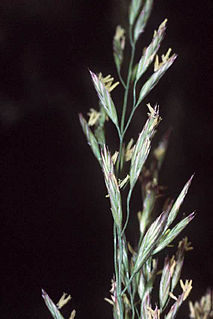
Festuca (fescue) is a genus of flowering plants belonging to the grass family Poaceae. They are evergreen or herbaceous perennial tufted grasses with a height range of 10–200 cm (4–79 in) and a cosmopolitan distribution, occurring on every continent except Antarctica. The genus is closely related to ryegrass (Lolium), and recent evidence from phylogenetic studies using DNA sequencing of plant mitochondrial DNA shows that the genus lacks monophyly. As a result, plant taxonomists have moved several species, including the forage grasses tall fescue and meadow fescue, from the genus Festuca into the genus Lolium, or alternatively into the segregate genus Schedonorus.
NVC community CG7 is one of the calcicolous grassland communities in the British National Vegetation Classification system. It is one of three short-sward communities associated with heavy grazing, within the lowland calcicolous grassland group, and is regarded as the eastern counterpart of "typical" chalk grassland.
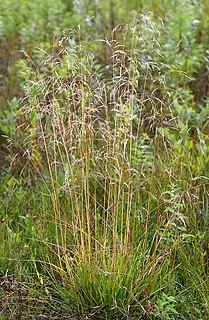
Deschampsia cespitosa, commonly known as tufted hairgrass or tussock grass, is a perennial tufted plant in the grass family Poaceae. Distribution of this species is widespread including the eastern and western coasts of North America, parts of South America, Eurasia and Australia.
British NVC community OV39 is one of the open habitat communities in the British National Vegetation Classification system. It is one of six communities of crevice, scree and spoil vegetation.

Festuca rubra is a species of grass known by the common name red fescue or creeping red fescue. It is widespread across much of the Northern Hemisphere and can tolerate many habitats and climates. It is best adapted to well-drained soils in cool, temperate climates; it prefers shadier areas and is often planted for its shade tolerance. Wild animals browse it, but it has not been important for domestic forage due to low productivity and palatability. It is also an ornamental plant for gardens.
The Orto Botanico dell'Università di Camerino, also known as the Orto Botanico di Camerino, is a nearly 1 hectare botanical garden operated by the University of Camerino, and located at Viale Oberdan 2, Camerino, Province of Macerata, Marche, Italy.

Tussock grasses or bunch grasses are a group of grass species in the family Poaceae. They usually grow as singular plants in clumps, tufts, hummocks, or bunches, rather than forming a sod or lawn, in meadows, grasslands, and prairies. As perennial plants, most species live more than one season. Tussock grasses are often found as forage in pastures and ornamental grasses in gardens.

Seub Nakhasathien was a Thai conservationist, environmental activist, and scholar who is renowned for his effort to protect Cheow Lan Lake, Thungyai Naresuan Wildlife Sanctuary, and Huai Kha Khaeng Wildlife Sanctuary. Seub committed suicide to signify the importance of the environment and to preserve it. According to the Bangkok Post, "The death of Seub Nakhasathien, a forest conservator who committed suicide in 1990,...helped transform the status of Thungyai Naresuan and the adjacent Huay Kha Kaeng Western Forest Complex into a sacrosanct site and inspired many youth to become forest patrol staff."

The Bottoms is a Site of Special Scientific Interest in County Durham, England. It lies just south of the A181 road, roughly midway between the villages of Cassop and Wheatley Hill, some 10 km south-east of Durham city.
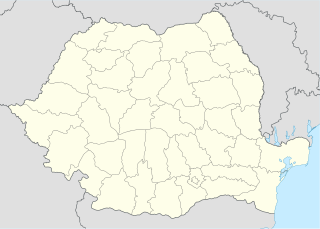
Lapiș Forest nature reserve IUCN category IV, is located in northwestern Romania, in the west of Sălaj County, near the village of Nușfalău, which is about 9 km from Șimleu Silvaniei.

Baixo Islet, also known locally as Ilhéu do Carapacho and historically as Ilhéu dos Homiziados, is a small uninhabited islet group located off the southeast coast of the island of Graciosa in the Portuguese archipelago of the Azores. Along with Praia Islet to its north, Baixo Islet is one of two main breeding places of Monteiro's storm petrel, an endemic marine bird of the Azores.

Praia Islet is a highly vegetated uninhabited islet located approximately 1.5 kilometres away from the town of Praia off the eastern coast of the island of Graciosa in the Portuguese archipelago of the Azores. Along with Baixo Islet to its south, Praia Islet is one of two main breeding places of Monteiro's storm petrel, an endemic marine bird of the Azores.

Topo Islet is a vegetated uninhabited islet just off the extreme southeastern tip of the island of São Jorge in the Portuguese archipelago of the Azores.
Festuca groenlandica, commonly known as the Greenland fescue, is a species of grass in the Festuca genus and Poaceae family. It is endemic to Greenland. The Flora of North America accepts this species. Other sources regard it as a synonym of Festuca brachyphylla.

Sanicula azorica, the Azores sanicle, is a perennial plant in the family Apiaceae. It is endemic to the Azores, Portugal.
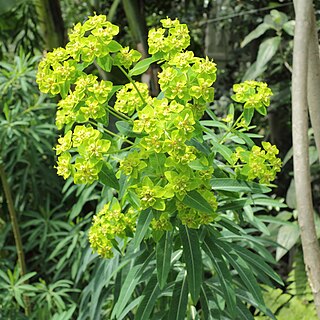
Euphorbia azorica is a species of flowering plant in the spurge family Euphorbiaceae, endemic to the Azores, Portugal.
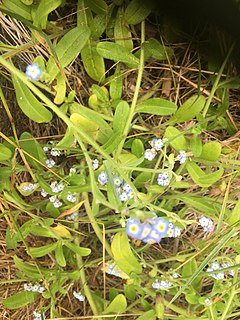
Myosotis maritima is a species of flowering plant in the family Boraginaceae endemic to the Azores. It is found in rocks, cliffs and coastal landslides, at altitudes generally below 50 m (160 ft). It is present in all of the islands.














